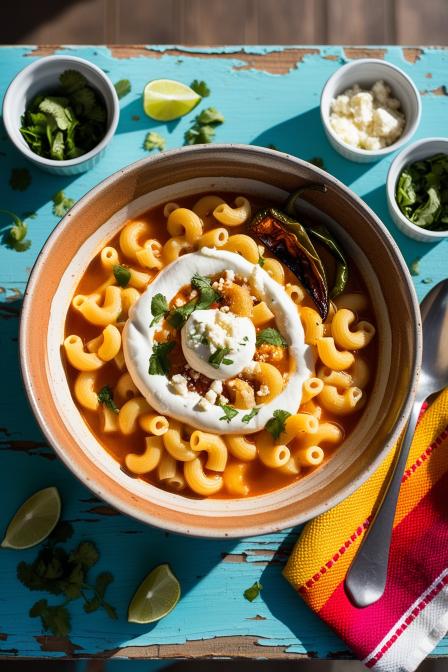I remember the first time I tried to make mac and cheese healthy. I was hungry, broke, and stubbornly committed to my gym goals. All I had was a half-empty tub of Greek yogurt, a lonely box of chickpea pasta, and an irrational craving for gooey cheese. What came outta that kitchen was weirdly amazing. Not grandma’s classic, sure—but rich, creamy, and light enough that I didn’t immediately fall into a food coma.
Now, low-calorie high-protein mac and cheese isn’t some mythical unicorn. It’s real. It’s hearty. It’s balanced. And it absolutely does not taste like sacrifice. What makes this version special is that it keeps the soul of comfort food while slipping in protein-rich swaps and trimming the fat—without gutting the flavor. We’re talkin’ velvety cheese sauce, tender pasta, a buttery crumb topping if you’re feeling it—just with smarter choices.
This recipe’s ideal for athletes, meal-preppers, busy parents, or literally anyone who wants to enjoy cheesy pasta without the guilt bomb. Let’s dig into the blueprint.
Ingredients & Substitutions
Here’s what you’ll need, along with clever little substitutions for different diets, preferences, or pantry situations.
| Ingredient | Amount | Substitutions | Notes |
|---|---|---|---|
| High-protein pasta (chickpea, lentil, edamame) | 8 oz | Whole wheat, regular, or GF pasta | Avoid overcooking—these pastas can go mushy fast |
| Cottage cheese (low-fat) | 1 cup | Greek yogurt or ricotta | High protein, adds creaminess |
| Unsweetened almond milk | 1/2 cup | Any low-fat milk, oat milk, or skim | Keep it unsweetened, trust me |
| Reduced-fat shredded cheddar | 1 cup | Regular cheddar, vegan cheese, or gouda | Use sharp cheddar for max flavor with less cheese |
| Parmesan (grated) | 2 tbsp | Nutritional yeast (for vegan) | Adds that salty punchy depth |
| Dijon mustard | 1 tsp | Yellow mustard or omit | Boosts umami, weird but necessary |
| Garlic powder | 1/2 tsp | Fresh garlic or shallots | Garlic = comfort, don’t skip |
| Salt & pepper | To taste | — | Go generous with pepper |
| Optional: whey protein isolate (unflavored) | 2 tbsp | Collagen powder or skip | Great protein boost without ruining taste |
Ingredient Notes
Pick a high-protein pasta with at least 13g protein per serving. Chickpea or lentil varieties usually hit the mark. Traditional pasta’s fine if that’s what ya got—but won’t be as macro-friendly.
Low-fat cottage cheese? It melts smooth in the blender and delivers serious cream factor. Just don’t eat it cold outta the tub if you’re texture-sensitive (been there). Greek yogurt works too but adds tang.
Sharp cheddar gives that full cheese payoff without loading up too much. Blend it with a tiny bit of Parmesan or nutritional yeast for depth.
Step-by-Step Instructions
- Boil the pasta in well-salted water until just al dente.
- Watch it close—protein pastas cook fast and go soft quick. Drain and rinse under cool water to stop the cooking.
- Make the cheese sauce.
- In a blender or food processor, toss in cottage cheese, almond milk, Dijon mustard, garlic powder, salt, pepper, and optional protein powder.
- Blend until silky smooth. No lumps. You want it creamy like a thick milkshake, not gritty.
- Heat the sauce.
- Pour that sauce into a saucepan on low heat. Stir gently till it’s hot. Don’t boil—cottage cheese gets weird if you do.
- Add the cheddar and Parmesan slowly, stirring until melted. Now it’s goo.
- Combine pasta + sauce.
- Fold the drained pasta into the sauce. Coat every piece like it’s being hugged by cheese. Simmer low for 2–3 mins to let it thicken.
- Optional: Broil it.
- Transfer to a baking dish. Sprinkle with more cheese or whole wheat breadcrumbs. Broil 2–4 mins till golden.
- Taste and adjust.
- Add more pepper. Maybe a lil’ splash of hot sauce. Get it just right.
Expert Tips
- Want it extra creamy? Add a splash more milk and keep the sauce moving.
- Sauce too thick? Thin with pasta water. Sauce too thin? Add more cheese or simmer longer.
- If your blender leaves it gritty, strain the sauce before heating.
Common Mistakes
- Overcooking the pasta. Especially with high-protein versions, they get soggy.
- Boiling the sauce. Keep it gentle or it might separate.
- Using sweetened milk. This will ruin your day.
Variations
- Spicy: Add 1 tsp cayenne or hot smoked paprika.
- Herby: Stir in chopped chives or basil at the end.
- Chicken add-in: Mix in cooked shredded chicken breast.
Cooking Techniques & Science
This recipe uses blended dairy instead of a roux for the base. Why? Saves calories, ups protein, skips the butter-flour-milk trifecta. Blending cottage cheese smooth transforms its grainy texture into a silky emulsion.
The almond milk thins it out without heavy fat. Cheese melts into it, thickening and flavoring. It’s like making a béchamel… but lazier. And healthier.
Why Dijon? Mustard enhances umami. It bridges dairy and pasta with a savory punch. Most folks can’t even tell it’s in there—it just deepens the cheesy vibe.
Whey protein isolate? Yep, that’s a gym hack. Flavorless, dissolves clean, adds 10-15g of protein per batch. But don’t use flavored versions or your mac’ll taste like birthday cake.
Tools You’ll Need
- High-speed blender or food processor: for blending the sauce smooth.
- Non-stick saucepan: to heat sauce evenly without sticking.
- Casserole dish: if you’re going the baked route.
- Silicone spatula: so nothing sticks and you get every last drip of cheese gold.
Storage & Reheating
Let leftovers cool fully. Store in an airtight container up to 4 days.
Reheat in the microwave or on stove with a splash of milk to loosen the sauce. Stir often. Add a lil’ cheese if it feels dry.
Avoid freezing—dairy sauce can separate when thawed.
Variations & Substitutions
- Vegan: Use silken tofu or cashew cream instead of cottage cheese. Swap in vegan cheddar.
- Gluten-free: Use gluten-free chickpea or rice pasta.
- Extra protein: Add grilled tofu cubes, shredded turkey, or seitan.
- Low sodium: Use no-salt cheese and skip the added salt.
Serving & Pairing Suggestions
Plate it hot. Scoop it into bowls or bake it into ramekins for individual portions.
Top with:
- Fresh chopped parsley
- Crushed red pepper
- Hot sauce swirl
- Sprinkle of smoked paprika
Pair with:
- Roasted broccoli or Brussels sprouts
- Grilled chicken or lean turkey
- Side salad with lemon vinaigrette
- Sparkling water with citrus, or dry white wine if you’re fancying
Best Time to Serve or Eat This Dish
Lunches where you need fuel but not a nap.
Post-gym dinner when you’re chasing protein macros.
Late-night comfort craving—this won’t weigh you down.
Meal prep Sundays. This holds up in the fridge and reheats like a champ.
Conclusion
This isn’t diet food pretending to be comfort food. This is comfort food that learned to level up.
By blending clever techniques with thoughtful ingredients, you get mac and cheese that’s rich in flavor, low in junk, and high in satisfaction. It’s creamy, tangy, melty, and shockingly light.
So next time someone tells you healthy food’s boring? Hand ’em a spoon.
FAQs
1. Can I use regular pasta instead of high-protein?
Yes, but the protein count will drop. Add a protein like chicken or tofu to balance.
2. Is it okay to skip the Dijon mustard?
You can, but it subtly enhances the cheese flavor. Try just a tiny bit!
3. Can I meal prep this for the week?
Absolutely. Store in airtight containers. Reheat with a splash of milk.
4. Will protein powder make it taste weird?
Not if you use unflavored isolate. Avoid flavored or thickened versions.
5. How can I make it creamier?
Use full-fat cottage cheese or add 1–2 tbsp of light cream cheese during blending.

